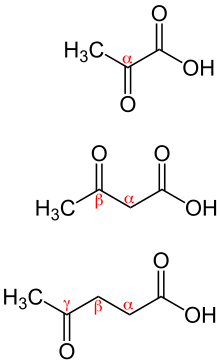Keto acid
Keto acids or ketoacids (also called oxo acids or oxoacids) are organic compounds that contain a carboxylic acid group and a ketone group.[1] In several cases, the keto group is hydrated. The alpha-keto acids are especially important in biology as they are involved in the Krebs citric acid cycle and in glycolysis.[2]

Common types of keto acids include:
- Alpha-keto acids, Alpha-ketoacids, or 2-oxoacids, such as pyruvic acid, have the keto group adjacent to the carboxylic acid. One important alpha-keto acid is oxaloacetic acid, a component of the Krebs cycle.[3] Another is alpha-ketoglutarate, a 5-carbon ketoacid derived from glutamic acid. Alpha-ketoglutarate participates in cell signaling by functioning as a coenzyme,[4] and is commonly used in transamination reactions. Alpha-keto acids possesses extensive chemistry as acylation agents.[5]
- Beta-keto acids, Beta-ketoacids, or 3-oxoacids, such as acetoacetic acid, have the ketone group at the second carbon from the carboxylic acid. They can be formed by the Claisen condensation.
- Gamma-keto acids, Gamma-ketoacids, or 4-oxoacids, such as levulinic acid, have the ketone group at the third carbon from the carboxylic acid.
Keto acids appear in a wide variety of anabolic pathways in metabolism, across living organisms. For instance, in plants (specifically, in hemlock, pitcher plants, and fool's parsley), 5-oxo-octanoic acid is converted in enzymatic and non-enzymatic steps into the cyclic class of coniine alkaloids.
When ingested sugars and carbohydrate levels are low, stored fats and proteins are the primary source of energy production. Glucogenic amino acids from proteins are converted to glucose. Ketogenic amino acids can be deaminated to produce alpha keto acids and ketone bodies.
Alpha keto acids are used primarily as energy for liver cells and in fatty acid synthesis, also in the liver.
See also
- Ulosonic acids
- Pseudoacid
References
- Franz Dietrich Klingler, Wolfgang Ebertz "Oxocarboxylic Acids" in Ullmann's Encyclopedia of Industrial Chemistry 2005, Wiley-VCH, Weinheim. doi:10.1002/14356007.a18_313
- Nelson, D. L.; Cox, M. M. "Lehninger, Principles of Biochemistry" 3rd Ed. Worth Publishing: New York, 2000. ISBN 1-57259-153-6.
- Kerber, Robert C.; Fernando, Marian S. (October 2010). "α-Oxocarboxylic Acids". Journal of Chemical Education. 87 (10): 1079–1084. doi:10.1021/ed1003096.
- Hewitson, K.S.; McNeill, L.A.; Elkins, J.M.; Schofield, C.J. (1 June 2003). "The role of iron and 2-oxoglutarate oxygenases in signalling". Biochemical Society Transactions. 31 (3): 510–515. doi:10.1042/bst0310510.
- Penteado, Filipe; Lopes, Eric F.; Alves, Diego; Perin, Gelson; Jacob, Raquel G.; Lenardão, Eder J. (16 April 2019). "α-Keto Acids: Acylating Agents in Organic Synthesis". Chemical Reviews. doi:10.1021/acs.chemrev.8b00782.
External links
- Keto+Acids at the US National Library of Medicine Medical Subject Headings (MeSH)